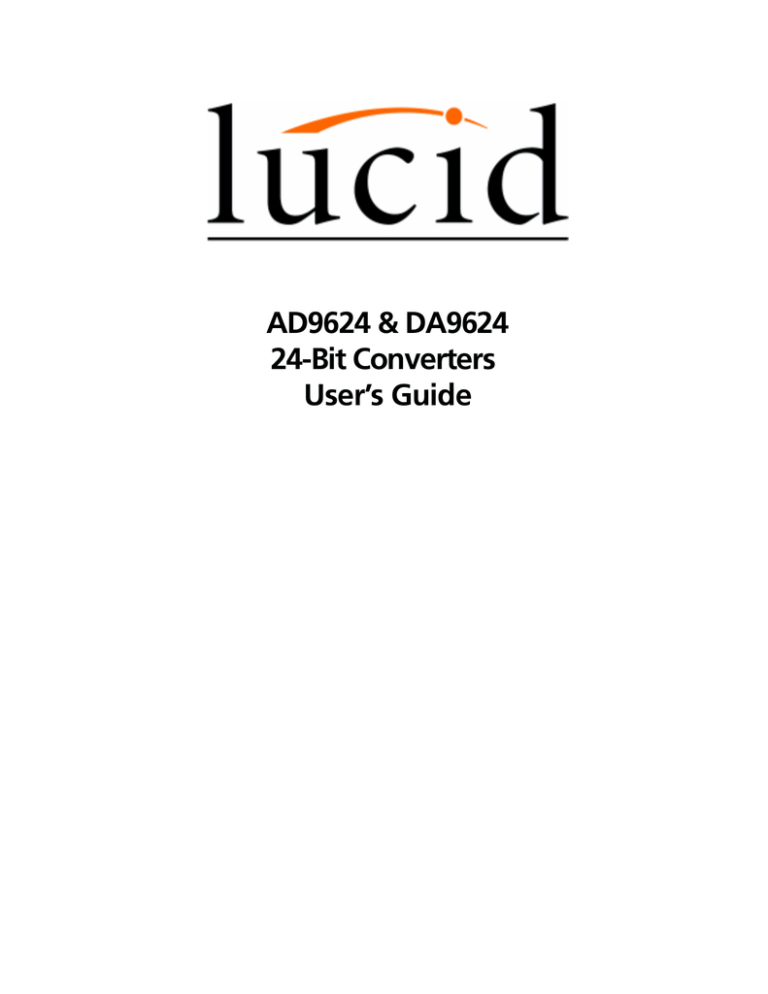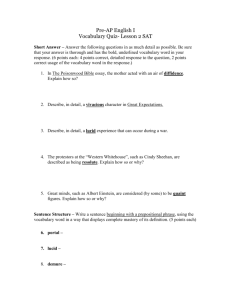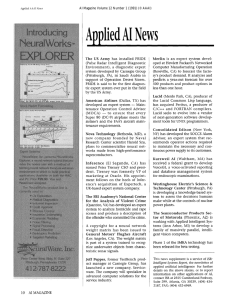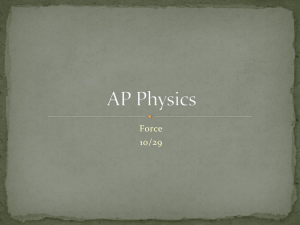
AD9624 & DA9624
24-Bit Converters
User’s Guide
TABLE
OF
CONTENTS
Section 1
Introduction
1
Section 2
Operator Safety Summary
2
Section 3
Fast Setup
Section 4
AD9624
4
DA9624
6
Product Description
AD9624 Front Panel Overview
8
AD9624 Rear Panel Overview
9
DA9624 Front Panel Overview
10
DA9624 Rear Panel Overview
11
Section 5
Using the AD9624 & the DA9624
Section 6
Specifications
12
AD9624
16
DA9624
17
Section 7
Warranty and Service
18
Section 8
Declaration of Conformity
19
Rev C.00, 27 January, 2000
Lucid part number 5396240C00
Specifications subject to change without notice.
©2000 Lucid. All rights reserved.
Lucid is a registered trademark of Symetrix, Inc.
Mention of third-party products is for informational purposes only and
constitutes neither an endorsement nor a recommendation. Lucid assumes
no responsibility with regard to the performance or use of these products.
Under copyright laws, no part of this manual may be reproduced or
transmitted in any form or by any means, electronic or mechanical,
including photocopying, scanning, recording or by any information storage
and retrieval system, without permission, in writing, from Lucid.
Lucid
6408 216th St. SW
Mountlake Terrace, WA 98043 USA
Tel: 425.778.7728
Fax: 425.778.7727
Email: lucid@lucidaudio.com
Website: www.lucidaudio.com
INTRODUCTION
SECTION 1
The Lucid AD9624 24-bit A/D Converter and DA9624 24-bit D/A Converter each provide
24-bit conversion for recording, mastering or post production systems. Both two-channel units
also offer 96kHz conversion for maximum sampling bandwidth.
The AD9624 accepts two balanced or unbalanced analog audio signals and delivers 24-bit
digital audio via AES/EBU, TOSLINK, or S/PDIF digital outputs. The internally generated
sample rates are: 32kHz, 44.1kHz, 48kHz, 88.2kHz, and 96kHz. The AD9624 also provides
optional 16-bit noise shaping on all outputs. Two twenty-segment LED meters allow easy yet
accurate level setting. The AD9624 is intended for use in +4dBu signal level systems.
The DA9624 accepts one AES/EBU, TOSLINK, or S/PDIF 24-bit digital input and delivers
two balanced or unbalanced analog outputs. The DA9624 provides digital-to-analog conversion
at sample rates of 96kHz, 88.2kHz, 48kHz, 44.1kHz, and 32kHz. An independent headphone
output allows instant monitoring. Two twenty-segment LED ladders guide you through output
level setting. The analog output signals appear on XLR-3 and ˘-inch TRS connectors for easy
connection to both balanced and unbalanced systems. The DA9624 operates at +4dBu signal
levels.
Both converters are housed in a half-rack sized chassis. The RM-4 rack mount tray (not supplied) mounts any two 9624 series modules in one unit of rack space.
Both converters require an external power supply, the Lucid PS-3 or Lucid PS-3E (export). One
supply is required for each converter.
This manual covers both products. We recommend that you read this manual from cover to
cover. Somewhere between the confines of the two covers you should find the answers to most
(98%) of your questions, both technical as well as musical. Please feel free to contact us if you
have additional questions, comments or suggestions.
Phone: 425.778.7728
Fax:
425.778.7727
Email:
lucid@lucidaudio.com
CHANNEL 1 HEADROOM (dB)
SOURCE
SAMPLE
CLOCK
FORMAT
CHANNEL 1/
LINK
CHANNEL 2
INT EXT
42 39 36 33 30 27 24 21 18 15 12 99 66 55 44 33 22 11 00 C
C
SAMPLE RATE
32 44.1 48
SOURCE AES/EBU
88.2 96
CHANNEL 2 HEADROOM (dB)
S/PDIF
AD
9624
LINK
24 BIT
16 NS
RATE
AD9624 24-Bit A/D Converter
CHANNEL 1 LEVEL (dBu)
INPUT
SELECT
AES/EBU
S/PDIF
S/PDIF
COAXIAL
TOSLINK
VOLUME
OUTPUT LEVEL
DA
9624
CHANNEL 2 LEVEL (dBu)
DA9624 24-Bit D/A Converter
1
OPERATOR SAFETY SUMMARY
SECTION 2
Equipment Markings
The lightning flash with arrowhead symbol within an
equilateral triangle is intended to alert the user of the
presence of uninsulated “dangerous voltage” within the
product's enclosure that may be of sufficient magnitude to
constitute a risk of electric shock to persons.
The exclamation point within an equilateral triangle is
intended to alert the user of the presence of important
operating and maintenance (servicing) instructions in the
literature accompanying the product (i.e. this manual).
Caution
CAUTION
RISK OF ELECTRIC SHOCK
DO NOT OPEN
TO REDUCE THE RISK OF FIRE OR
SHOCK DO NOT EXPOSE
WARNING: ELECTRIC
THIS EQUIPMENT TO RAIN OR MOISTURE
DE CHOC ELECTRIQUE
AVIS: RISQUE
NE PAS OUVRIR
SEE OWNERS MANUAL. VOIR CAHIER D’INSTRUCTIONS.
No user serviceable parts inside. Refer servicing to qualified service personnel.
Il ne se trouve a l’interieur aucune piece pourvant entre reparée l’usager.
S’adresser a un reparateur compétent.
To prevent electric shock, do not use the polarized plug
supplied with the unit with any extension cord, receptacle, or other outlet unless the blades can be fully inserted.
Terms
Several notational conventions are used in this manual. Some paragraphs may use Note, Caution, or
Warning as a heading or certain typefaces and capitalization are used to identify certain words. These are:
Note
Identifies information that needs extra emphasis. A Note generally supplies extra information to help you
to better use the product.
Caution
Identifies information that, if not heeded, may cause damage to the Lucid product or other equipment in your system.
Warning
Identifies information that, if ignored, may be hazardous to your health or that of others.
CAPITALS Controls, switches or other markings on the product’s chassis.
Important Safety Instructions
Please read and keep these instructions. Heed and follow all warnings and instructions.
Mains Voltage Selection
The AD9624 and DA9624 converters use an external power supply
(Lucid PS-3 or PS-3E). The choice of power supply determines the
mains voltage required for proper operation. Refer to power supply
markings for the correct AC source value.
Grounding
The chassis of this product is grounded through the grounding
conductor of the power cord. To avoid electric shock, plug the power
cord into a properly wired receptacle before making any connections to
the product. A protective ground connection, by way of the grounding
conductor in the power cord, is essential for safe operation. Do not
defeat the safety purpose of the grounding plug. The grounding plug
has two blades and a third grounding prong. The third prong is provided
for your safety. When the provided plug does not fit your outlet, consult
an electrician for replacement of the obsolete outlet.
2
Danger from Loss of Ground If the protective ground connection is lost, all accessible conductive
parts, including knobs and controls that may appear to be insulated,
can render an electric shock.
Operating Location
Do not operate this equipment under any of the following conditions:
explosive atmospheres, in wet locations, in inclement weather, improper
or unknown AC mains voltage, or if improperly fused. Do not install
near any heat source such as radiators, heat registers, stoves, or other
apparatus (including amplifiers) that produce heat. Unplug this apparatus
during lightning storms or when unused for long periods of time.
Stay Out of the Box
To avoid personal injury (or worse), do not remove the product covers or
panels. Do not attempt to disassemble the external power supply. Do
not operate the product without the covers and panels properly
installed. Only use accessories specified by the manufacturer.
Clean only with a damp cloth.
3
FAST SETUP - AD9624
SECTION 3
This section discusses a multitude of things, all related to getting signals in and out of the
AD9624 and getting on with using it.
0 dB
-2
-4
8 TRACK PROFESSIONAL DIGITAL AUDIO RECORDER
-6
-9
-12
-15
-18
-22
-27
-32
AUTO INPUT
MONITOR
FORMAT
PITCH
ALL INPUT
MONITOR
DIGITAL IN
PITCH
MINUTES
LOCATE 1
LOCATE 2
AUTO 2>1
SET LOCATE
LOCATE 0
AUTO PLAY
SECONDS
-38
-44
-51
-60
1
2
3
4
5
6
7
8
1
2
3
4
5
6
7
8
RECORD
INPUT
Analog outputs
from mixer or
other audio source.
ANALOG INPUTS
POWER
REWIND
DIGITAL OUTPUTS
SYNC
INPUT
PLAY
RECORD
EJECT
CONNECT TO
LUCID PS-3 OR
PS-3E POWER
SUPPLY ONLY.
TOSLINK
AES/EBU
AD9624
24-BIT A/D
CONVERTER
MANUFACTURED BY LUCID TECHNOLOGY. LYNNWOOD, WA, US.A
COAXIAL
CHANNEL 2
STOP
Digital outputs
to DAT and
Computer
Workstation
inputs. All
outputs are
active at
the same time.
S/PDIF
CHANNEL 1
FAST FWD
WORD CLK
POWER
INPUT
THIS PRODUCT CONTAINS NO USER SERVICABLE PARTS.
FABRIQUÉ AUX E.-U. PAR LUCID TECH., LYNNWOOD, WA.,USA.
RÉFÉREZ TOUTE RÉPARATION À UN TECHNICIEN QUALIFIÉ.
Figure 3-1. AD9624 Connections
Analog Input Connections
Connect your analog sources to the rear-panel analog input connectors. These connectors may
be driven from a balanced or unbalanced, low-impedance source. When using an unbalanced
source, the preferred connection method is to bring all three input connections through to the
unbalanced source, tying the shield to the source ground, pin 2/hot to the source hot, and pin
3/cold to the source ground.
The AD9624 is designed to operate around nominal +4dBu signal levels.
Digital Output Connections
It is not necessary to connect to all of these connectors at any given time. The connectors used
or not used depend on your specific application.
Connect the AES/EBU output connectors to AES/EBU digital audio inputs.
Connect the TOSLINK S/PDIF connectors to an optical consumer digital audio input.
Connect the RCA (coaxial) S/PDIF connector to a consumer digital audio input.
Connect the Sync/Word Clock input connector to a source of digital audio word clock.
4
Settings
Set the front panel switches as required by your situation and by the equipment connected to
the rear panel connectors. If you are driving a 16-bit device, then use the 16-bit noise shaping
to handle the lower eight bits of data.
Set your levels as you would for any digital audio processor. If you use a tone to line the meters
up with your console, then with your console’s meters at 0VU, set the level controls for
either -18dBFS or -12dBFS on the AD9624’s meters. This is just a starting point, and you may
want to alter this relationship. Set your levels low enough that the CLIP indicator never illuminates.
The LINK switch makes the Channel 1 level control affect both channels simultaneously.
When the switch is DOWN, the two level controls act independently.
5
FAST SETUP - DA9624
This section discusses a multitude of things, all related to getting signals in and out of the
DA9624 and getting on with using it.
0 dB
-2
-4
8 TRACK PROFESSIONAL DIGITAL AUDIO RECORDER
-6
-9
-12
-15
Analog outputs
of DA9624 to
line level inputs
of mixer or
other audio source.
-18
-22
-27
-32
-44
FORMAT
PITCH
ALL INPUT
MONITOR
DIGITAL IN
PITCH
MINUTES
LOCATE 1
LOCATE 2
AUTO 2>1
SET LOCATE
LOCATE 0
AUTO PLAY
SECONDS
-60
1
2
3
4
5
6
7
8
1
2
3
4
5
6
7
8
RECORD
INPUT
POWER
REWIND
FAST FWD
STOP
PLAY
RECORD
EJECT
Digital outputs
from DAT and
Computer
Workstation.
Input is
selected
by frontpanel
switch controls.
ANALOG OUTPUTS
DIGITAL INPUTS
DA9624
S/PDIF
COAXIAL
TOSLINK
CHANNEL 1
AUTO INPUT
MONITOR
-38
-51
CHANNEL 2
AES/EBU
24-BIT D/A
CONVERTER
MANUFACTURED BY LUCID TECHNOLOGY. LYNNWOOD, WA, US.A
CONNECT TO
LUCID PS-3 OR
PS-3E POWER
SUPPLY ONLY.
POWER
INPUT
THIS PRODUCT CONTAINS NO USER SERVICABLE PARTS.
FABRIQUÉ AUX E.-U. PAR LUCID TECH., LYNNWOOD, WA.,USA.
RÉFÉREZ TOUTE RÉPARATION À UN TECHNICIEN QUALIFIÉ.
Figure 3-2. Connections
Analog Output Connections
It is not necessary to connect to all of these connectors at any given time. The connectors used
or not used depend on your specific application.
Connect the analog outputs as required in your studio. These connectors deliver a balanced
output signal from a simulated grounded center-tap source.
For unbalanced use, internal jumpers allow configuring the output as floating balanced. This
configuration emulates a floating transformer winding and is tolerant of having one of its ends
grounded. With the jumpers configured as supplied from the factory, you must float (don’t
connect it) pin 3 or the sleeve.
Unbalanced Output Jumpers
The DA9624 has a pair of floating-balanced output drivers that are available via internal jumpers. The floating balanced output emulates a floating transformer winding. You should use
these when one or more of the following conditions are true:
·
·
6
Your application requires that you be able to plug the outputs of the DA9624 into a wide
variety of inputs that may be balanced or unbalanced.
You want to use the DA9624 with an unbalanced input and you don’t have a TRS cable
with the ring connection open circuited.
To enable the floating balanced output:
1. Remove the cover from the DA9624 by removing
the four top cover screws and the 2 screws on each
side of the unit.
2. Remove the cover and set it aside.
3. Locate the jumpers (about an inch from the rear of
the unit and between the two analog output XLR
connections).
4. For floating balanced output, the four jumpers
should be installed at positions 2-3 (four places). For
the default differential balanced output, install the
four jumpers at positions 1-2.
5. Replace the cover and reinstall the cover screws. It
may be handy to add a piece of suitably marked tape
to the unit indicating the jumper status.
When using the DA9624 with unbalanced inputs, it is extremely important that the conversion
to an unbalanced signal occur at the DA9624 rather than at the receiving device.
G
2
G
1
3
2
J14
1
C106
C75
L9
J13
3
J21
C62
L12
C114
L14
J18
L15
C94
C111
C67
C113
C108
R65
R67
C104
R63
C87
C83
U27
C89
C76
C72
C103
R54
R52
R34 C63
R43
R46
C71
U22
R38
R39
C66
C112
U28
R49
C65
R36
J19 J20
123
J15 J17
C64
U21
U23
C73
R40
R58
C98
R59
R68
C109
C84
This output configuration decreases the dynamic range by 1dB.
Digital Input Connections
It is not necessary to connect to all of these connectors at any given time. The connectors used
or not used depend on your specific application.
Connect the AES/EBU input connectors to AES/EBU digital audio sources.
Connect the S/PDIF connectors to consumer audio digital inputs. Use the TOSLINK optical
connector for S/PDIF optical signals.
Select the appropriate input connector via the front panel switch.
Level Setting
The front panel level control determines the output level of the DA9624. The meters monitor
the analog outputs of the unit. Set the level control so that the output level remains below
clipping. Note that it is possible for the input of the receiving device to clip before the
DA9624’s output do. In most cases, reducing the gain setting of the receiving (downstream)
device doesn’t help, as the source of the overload is ahead of the gain control. The proper
course of action here is to reduce the output level of the DA9624 by reducing the setting of the
Output Level control.
7
PRODUCT DESCRIPTION - AD9624 FRONT PANEL OVERVIEW
CHANNEL 1 HEADROOM (dB)
SOURCE
SAMPLE
CLOCK
FORMAT
SECTION 4
CHANNEL 1/
LINK
CHANNEL 2
INT EXT
42 39 36 33 30 27 24 21 18 15 12 99 66 55 44 33 22 11 00 C
C
SAMPLE RATE
32 44.1 48
SOURCE AES/EBU
88.2 96
CHANNEL 2 HEADROOM (dB)
S/PDIF
LINK
24 BIT
16 NS
AD
9624
RATE
METER window
Displays the signal levels, sample rate, output protocol, and
presence of valid word clock.
LED meters
20-segment LED bargraph meters display digital output signal
levels. These meters are peak responding with peak-hold. The
(labeled ‘C’) indicator requires three consecutively clipped
samples to illuminate.
Clip
Sample Rate display
Displays the selected sample rate as well as the source of
Word Clock.
SAMPLE RATE switch
Three-position momentary toggle switch. Toggling the switch UP
selects between internal and external clock sources. Toggling the
switch DOWN selects between 32, 44.1, 48, 88.2, and 96kHz
sample rates.
WORD LENGTH
switches
Selects between 24-bit and 16-bit word lengths for the AES/EBU
and S/PDIF outputs. The 16-bit setting incorporates noise
shaping into the conversion process.
Note You may select different word lengths for the different
protocols.
CHANNEL 1/LINK
Adjusts sensitivity of the analog input(s). When the LINK switch
is control set to the LINK position, this control simultaneously
adjusts the level of both channels.
CHANNEL 2 control
Adjusts the sensitivity of the analog input for channel 2. This
control is only active when the LINK switch is set to the DOWN
position.
8
PRODUCT DESCRIPTION - AD9624 REAR PANEL OVERVIEW
ANALOG INPUTS
DIGITAL OUTPUTS
SYNC
INPUT
S/PDIF
COAXIAL
CONNECT TO
LUCID PS-3 OR
PS-3E POWER
SUPPLY ONLY.
TOSLINK
CHANNEL 1
CHANNEL 2
AES/EBU
AD9624
24-BIT A/D
CONVERTER
MANUFACTURED BY LUCID TECHNOLOGY. LYNNWOOD, WA, US.A
WORD CLK
POWER
INPUT
THIS PRODUCT CONTAINS NO USER SERVICABLE PARTS.
FABRIQUÉ AUX E.-U. PAR LUCID TECH., LYNNWOOD, WA.,USA.
RÉFÉREZ TOUTE RÉPARATION À UN TECHNICIEN QUALIFIÉ.
Analog Inputs
Two XLR-3 female connectors. These connectors accept analog
audio signals from balanced or unbalanced sources. The input
impedance is 10k balanced or 5k unbalanced. The input topology
is a simple differential amplifier. The maximum input level is
+25dBu. This connector should be driven from a low source
impedance. Be sure to ground the low side of the input (pin 3)
when connecting unbalanced sources. Ideally pin 3 would be
connected to pin 1 at the unbalanced source.
AES/EBU Output
XLR-3 male connector. This connector delivers digital audio
signals using the AES-3 protocol. A front-panel switch determines
the word length for this output.
S/PDIF Output
TOSLINK (optical) and RCA female (coaxial) connector. These
connectors deliver S/PDIF digital audio signals. A front-panel
switch determines the word length for this output.
Sync/Word Clock
BNC male connector. This connector accepts word clock signals.
Word clock is a method of synchronizing multiple digital audio
signals.
AC Power Input
7-pin DIN connector. Use only Lucid PS-3 or Lucid PS-3E power
supplies. Connect only to appropriate AC power source. Refer to
power supply marking for correct AC source value.
The choice of power supply determines the proper AC mains
voltage required for operation.
Note There are no fuses, user accessible or not.
9
PRODUCT DESCRIPTION - DA9624 FRONT PANEL OVERVIEW
CHANNEL 1 LEVEL (dBu)
INPUT
SELECT
AES/EBU
S/PDIF
S/PDIF
VOLUME
COAXIAL
TOSLINK
OUTPUT LEVEL
DA
9624
CHANNEL 2 LEVEL (dBu)
METER window
Displays the signal levels, sample rate, and presence of valid
digital audio source data.
LED meters
20-segment LED bargraph meters display analog output signal
levels.
INPUT SELECT
Three-position toggle switch selects between AES/EBU, S/PDIF
coaxial, and S/PDIF TOSLINK digital audio inputs.
Headphone jack
1/4" TRS jack for stereo headphones. Suitable for headphones
with 60-ohm impedance or higher. For maximum smoke, use
headphones similar to the Sony MDR-7506, or anything that you
can drive to reasonable levels using a Sony Walkman®.1
VOLUME
Adjust volume level of Headphone Jack.
OUTPUT LEVEL
Ganged control simultaneously adjusts the output level of Left
and Right analog outputs.
1
Walkman is a trademark of Sony Corporation.
10
PRODUCT DESCRIPTION - DA9624 REAR PANEL OVERVIEW
ANALOG OUTPUTS
DIGITAL INPUTS
DA9624
S/PDIF
COAXIAL
TOSLINK
CHANNEL 1
CHANNEL 2
AES/EBU
24-BIT D/A
CONVERTER
MANUFACTURED BY LUCID TECHNOLOGY. LYNNWOOD, WA, US.A
CONNECT TO
LUCID PS-3 OR
PS-3E POWER
SUPPLY ONLY.
POWER
INPUT
THIS PRODUCT CONTAINS NO USER SERVICABLE PARTS.
FABRIQUÉ AUX E.-U. PAR LUCID TECH., LYNNWOOD, WA.,USA.
RÉFÉREZ TOUTE RÉPARATION À UN TECHNICIEN QUALIFIÉ.
Analog Outputs
XLR-3 male and 1/4-inch TRS connectors. These parallel-wired
connectors deliver balanced audio signals from a 102-ohms
source. The output stage emulates a grounded center-tapped
transformer. The maximum output level is +25 dBu For unbal
anced loads, either float the unused output pin (usually pin 3 or
ring), or if you have no other choice, ground it at the DA9624.
Digital Inputs
Select the desired input via the front panel switch.
XLR-3 female
This connector accepts digital audio signals using the AES-3
connector protocol (which includes older AES/EBU signals).
TOSLINK optical
This connector accepts digital audio signals using the S/PDIF
connector protocol.
Coaxial connector
This RCA-female connector accepts digital audio signals using the
S/PDIF protocol.
AC Power Input
7-pin DIN connector. Use only Lucid PS-3 or Lucid PS-3E power
supplies. Connect only to appropriate AC power source. Refer to
power supply marking for correct AC source value.
The choice of power supply determines the proper AC mains
voltage required for operation.
Note There are no fuses, user accessible or not.
11
USING
THE
AD9624 &
THE
DA9624
SECTION 5
This chapter discusses various aspects of the operation of each converter. For the most part, this
applies to both units, but if it doesn’t, we’ll let you know.
Why 24-bit?
The obvious answer is: “More is better.” If you need more, consider:
·
The trouble zone for any converter is the last (lowest) one or two bits of resolution. At 24bit resolution, the amount of signal represented gets smaller, which means that if there is
trouble in the lowest bits, this represents less of the overall signal. Remember that the
output signal swing is fixed, so we’re simply dividing the output signal into smaller and
smaller pieces. Yes, in 24-bit converters, the output noise floor is also lower, and so we’re
actually getting two extra benefits for using a higher resolution converter.
·
If you’re mastering directly to DAT, using a 24-bit converter and letting the converter
dither the result to 16-bit is superior to using the 16-bit converters in your DAT machine.
·
For some material (especially if it has little dynamic range), you may get superior results by
converting to 24-bit and throwing away the last 8 bits (truncation).
·
If you’re downloading into a digital audio workstation (DAW) directly from your mixer
(and you have a 24-bit capable DAW), then it makes sense to use a high-resolution con
verter. Perform all workstation tasks at 24-bit wordlength, and do the final dithering to 16bit when you record the CD master disk. When you fiddle with signals in DSP, the simple
act of changing the gain can increase your wordlength. Having the extra resolution at the
onset means less error when the increase in wordlength exceeds the internal capabilities of
your DAW software (rounding error).
AD9624 Level Setting
Like any A/D converter, the converter’s digital output represents a fixed window that must
properly frame the audio signal. Set it too low, and lose the signal peaks; set it too high and lose
the low-level detail.
In the 16-bit world, when that was all there was for conversion, the placement of the converter
window was more critical due to the larger step size represented by each bit of the digital
output. Low level details in the signal represent things like ambience and soundstage; thus they
are critical details. Capturing these details faithfully means becoming more adept at either
setting the window properly or fitting the signal into the window itself via dynamic range
compression.
A 24-bit converter eases this task somewhat. Since the steps are smaller, you now have the
option of placing the audio signal either a bit higher (better resolution for low-level signals, but
lower headroom) or lower (less resolution for low levels, but more headroom). Of course, if the
signal is already recorded, then it’s just a matter of getting levels set properly and then making
the transfer into your digital recorder or workstation.
12
It’s conceivable that you might want to make a 24-bit recording directly into your DAW. In
this case, set your levels carefully and/or use some preprocessing in the analog domain to ensure
that the audio signal fits into the conversion window.
Because our ears are unable to detect short-duration clipping, the AD9624’s meter requires
three consecutively clipped samples in order to indicate clipping. Whatever you do, you should
try to avoid seeing the C (clip) segment on the AD9624’s meter.
Clock and Sync Issues
Any time that you have multiple digital audio signals at one time the issue of sync becomes
important. If you are using multiple AD9624s for multitrack work, it may be necessary to
synchronize the converters in all of the different converter boxes. You do this by using the
Word Clock input on the rear of the unit. You can chain multiple units together by using a Tee
connector. In many cases, the digital multitrack can handle non-synchronized sources, so this
may not be an issue. Experimentation (before that important session) is the key here.
To Dither or not to Dither, That is the question.
What is dither? Dither takes two forms: very low level white noise added to the signal before
conversion, or a similar process performed after conversion via a DSP chip. In some respects,
dither allows 16-bit digital to act more like good old-fashioned analog. No, there’s no tape
compression, but the ability to resolve details that reside in the noise floor (like ambience,
decay, and space) remains.
The second dither method mentioned above takes place in the digital domain. Having a 24-bit
wordlength allows this with a minimum of compromise. We can add white noise at a sufficiently low level to only modulate the last one or two bits of the 16-bit signal. This has the
effect of putting a slight veil on the signal, resulting in reduced soundstage, definition, and
clarity.
An improved method (which of course is what the AD9624 uses) is known as “noise shaping.”
Noise shaping alters the audibility of the dither signal by equalizing or shaping its spectrum.
This minimizes its audibility by moving the noise away from the parts of the spectrum where
our ears are most sensitive (-3kHz) and placing it into an area where our ears are less sensitive
(10-22kHz).
When should you dither? Once, and once only. Dithering should be your last step upon leaving
the 24-bit domain and entering the 16-bit domain.
13
System Interface
Interfacing any recently manufactured piece of audio equipment into your studio can be challenging, perhaps even painful. It doesn’t have to be. Still, with the wide variety of different
input and output circuit topologies, it doesn’t hurt to have a bit of background information.
Input
The AD9624 has two balanced inputs, appearing on XLR connectors. Pin 1 is ground, and it
connects directly to the chassis as well as to the internal circuit ground. Pin 2 is hot, and pin 3
is cold. A simple differential amplifier implements the balanced input.
Coming from a balanced system, it should be as simple as plug and play. Leave pin 1 connected
unless you hear hum. You can try lifting it (at the source). Use whichever method results in the
lowest noise floor. Ideally, you should only hear hiss.
Coming from an unbalanced system, the best connection method takes advantage of the
AD9624’s balanced input (in spite of the unbalanced source). Do this by running shielded
twisted pair (that’s 2 wires plus the shield; i.e. balanced mike cable) from the AD9624’s balanced input to the output of the unbalanced device. Once there, connect the hot lead to the
unbalanced source’s hot lead, connect the low lead and the shield together and connect them to
the ground of the unbalanced device.
Note If you want the absolute lowest noise floor, then you really should operate the AD9624
in a fully balanced environment.
Output
The DA9624 has two balanced outputs that appear both on XLR connectors as well as 1/4-inch
TRS connectors. The connectors are wired in parallel, so doing something electrically to one
affects the other. Two cascaded inverting amplifiers implement the balanced output. This
simulates a transformer winding with its center tap connected to ground.
In a balanced system, simply plug and play. Again, pin 1 is ground, pin 2 hot, and pin 3 cold.
You may need to float pin 1, preferably at the DA9624.
In an unbalanced system, things get a bit more complicated. There are three options.
1. Float (do not connect) the cold side of the output. For the XLR connector, this is pin 3,
for the TRS connector it is the ring. Note that there is a -6dB level difference for this
connection.
2. Insert a tip-sleeve phone plug into the TRS connector and go for it. The bad part of this
method is that one side of the balanced output gets to drive a dead short. The worst of it is
that the short circuit current (which is not musical in the least) flows into the ground
system,where it could cause trouble.
Please: try to do this only when forced to.
14
3. If you’re going to be installing the DA9624 into a situation where its outputs may be
driving an unbalanced input one moment and a balanced input the next, it is worth your
while to get inside the box and rearrange some jumpers. This configures the output stage as
a floating-balanced (cross-coupled) line driver and the balanced outputs behave like an
ungrounded (floating) transformer winding.
The advantage to doing this is that there is no level difference between balanced and unbalanced, and the circuit could care less if you ground the cold side to make it unbalanced. If you
do need to operate the DA9624 with its outputs unbalanced, do the unbalancing right at the
rear panel of the DA9624.
The procedure for changing the jumper settings can be found in Section 3 - Fast Setup.
Configuring the output this way reduces the dynamic range by about 1dB.
Digital I/O
The AD9624 has three digital outputs: AES/EBU (XLR-M), TOSLINK (optical), and Coaxial
(RCA). The TOSLINK and Coaxial outputs use the S/PDIF protocol primarily used by consumer equipment. The TOSLINK output is limited to about 30 feet (approx. 10 meters), and
the coaxial output is limited to about 10 feet (approx. 2 meters), depending on the quality of
the coaxial cable.
The AES/EBU output is balanced, and for long cable runs, you may want to use 110-ohm cable
to match the characteristic impedance of the output. (Beldin 1800A as an example. Runs of
several hundred feet are easily accomplished with this cable.)
Note The AD9624 has two front panel switches that select the noise shaping/wordlength for
the two output protocols. There are three different output jacks, and all of them are
active during use. You can use any combination of the outputs simultaneously. Be aware
that the S/PDIF switch affects both the coaxial (RCA) and TOSLINK connections.
The DA9624 has three digital inputs: AES/EBU (XLR-F), TOSLINK (optical) and Coaxial
(RCA). The AES/EBU input is balanced, and the coaxial input is unbalanced. However, both
inputs are transformer-isolated.
Note The DA9624 has a front panel switch that selects the input connection to be used. It is
permissible to have something connected to any of the inputs in any combination.
For More Information
Consult Bob Katz’ website: http://www.digido.com. Bob is a well-known and respected mastering engineer and his website has a wealth of information on it. This is worth your time.
15
SPECIFICATIONS - AD9624
Input/Output
Analog Inputs
Digital Outputs
Word Clock
Analog input impedance
Maximum analog input level
(at full CCW)
Maximum analog input level
(at full CW)
Performance Data
Internally generated sample rates
Conversion
THD+Noise
Dynamic Range
SECTION 6
Two balanced XLR
One AES/EBU (XLR), One S/PDIF (coaxial), One S/PDIF
(TOSLINK optical)
BNC
10kΩ balanced, 5kΩ unbalanced
+25 dBu balanced
+4 dBu balanced
96kHz, 88.2kHz, 48kHz, 44.1kHz, and 32kHz
and external sync via Word Clock
24-bit delta/sigma
< 0.002% (-1dBFS out, 1kHz)
> 115dB, A-weighted, input level at full CCW,
48kHz sampling rate
Frequency Response
For sample rates of 88.2kHz and 96kHz
For sample rates of 44.1kHz and 48kHz
For sample rate of 32kHz
Physical
Size (hwd), in & cm
Weight, lbs & kg
Electrical
Power requirements
Power supply
Note:
16
20Hz - 40kHz (+/-1dB)
20Hz - 20kHz (+/-0.5dB)
20Hz - 15kHz (+/-0.5dB)
1.72 in. (h) x 8.5 in. (w) x 8.25 in. (d)
4.37 cm. (h) x 21.59 cm. (w) x 20.96 cm. (d)
3.7 lbs (1.665 kg) net
6.6 lbs (2.97 kg) shipping
117V AC nominal, 105-125VAC 50-60 Hz, 10 watts
230V AC nominal, 205-253V AC 50 Hz, 10 watts
External AC (Lucid PS-3 or PS-3E) via 7-pin DIN connector
The maximum operating ambient temperature is
25 degrees C.
In the interest of continuous product improvement, Lucid Technology
reserves the right to alter, change, or modify these specifications without
prior notice.
SPECIFICATIONS - DA9624
Input/Output
Digital Inputs
Analog Outputs
Analog output impedance
Analog output gain range
Maximum analog output level
Maximum headphone output level
One AES/EBU (XLR), One S/PDIF (coaxial), One S/PDIF
(TOSLINK optical)
Two balanced XLR, two balanced and unbalanced 1/4" TRS,
One front panel-mounted headphone output (stereo 1/4" TRS)
100Ω balanced, 50Ω unbalanced,
Optional floating balanced line driver
-× to +25dB (+/-2dB)
+25dBu (+/-1dB)
20V peak to peak into 2000Ω,
80Ω output impedance
Performance Data
Conversion
24-bit delta/sigma
THD+Noise
< 0.002% (-1dBFS in, 1kHz)
Dynamic Range
> 114dB, A-weighted
Frequency Response
For sample rates of 88.2kHz and 96kHz
20Hz - 40kHz (+/-1dB)
For sample rates of 44.1kHz and 48kHz
20Hz - 20kHz (+/-0.5dB)
For sample rate of 32kHz
20Hz - 15kHz (+/-0.5dB)
Physical
Size (hwd), in & cm
Weight, lbs & kg
Electrical
Power requirements
Power supply
Note:
1.72 in. (h) x 8.5 in. (w) x 8.25 in. (d)
4.37 cm. (h) x 21.59 cm. (w) x 20.96 cm. (d)
3.7 lbs (1.665 kg) net
6.6 lbs (2.97 kg) shipping
117V AC nominal, 105-125VAC 50-60 Hz, 10 watts
230V AC nominal, 205-253V AC 50 Hz, 10 watts
External AC (Lucid PS-3 or PS-3E) via 7-pin DIN connector
The maximum operating ambient temperature is
25 degrees C.
In the interest of continuous product improvement, Lucid Technology
reserves the right to alter, change, or modify these specifications without
prior notice.
17
WARRANTY
AND
SERVICE
SECTION 7
Warranty
Following are the terms and limitations of the Lucid warranty.
Lucid expressly warrants to the original purchaser ("Buyer"), subject to the terms and conditions set forth below, that the Product will be
free from defects in material and workmanship as a result of normal commercial use for (18) months from the date of shipment.
Some Lucid products contain embedded software and may also be accompanied by control software intended to be run on a personal
computer. Said software is specifically excluded from this warranty.
Lucid's warranty obligation is limited to the repair, replacement, or refund at Lucid's sole discretion, of the part or parts of the Product
which may thus prove defective in materials or workmanship within (18) months from date of shipment under normal use and which our
examination discloses to our satisfaction to be thus defective, provided that Buyer gives Lucid prompt notice of its warranty claim and
satisfactory proof thereof.
Lucid will make every reasonable effort to ensure that parts are available to support the repair of our products under warranty. In the
event that a product or component part thereof becomes obsolete, unavailable or irreparable, Lucid reserves the right to refund a
prorated portion of the purchase price in full satisfaction of all warranty claims.
In order to serve you better we require that the Buyer shall, prior to shipping Product to Lucid for warranty service, contact Lucid and
secure a Return Authorization Number that shall be included with the returned Product. This will facilitate our efforts to keep track of
your Product and process your warranty repair as quickly as possible. Buyer will prepay all freight charges to ship the Product to Lucid
for warranty inspection and service. This warranty is subject to Lucid's inspection of the Product at its facilities and, upon Lucid's
request, satisfactory proof of purchase (dated copy of original retail dealer's invoice.)
Lucid reserves the right to effect repairs to the product with reconditioned components/parts. Products once repaired under warranty
will be shipped to Buyer freight prepaid by Lucid via United Parcel Service (surface) or any similar shipper, to any location designated
by buyer within the Continental United States. At Buyer's request and expense Product will be returned via airfreight. Outside the
continental United States, repaired or replaced products will be returned freight collect.
THIS WARRANTY IS EXPRESSLY IN LIEU OF ALL OTHER WARRANTIES EXPRESS OR IMPLIED, ARISING BY LAW OR
OTHERWISE (INCLUDING, WITHOUT LIMITATION ANY OBLIGATIONS OF THE SELLER WITH RESPECT TO CONSEQUENTIAL
DAMAGES) INCLUDING THE WARRANTIES OF MERCHANTABILITY AND FITNESS FOR USE AND OF ALL OTHER OBLIGATIONS OR LIABILITIES ON OUR PART, AND WE NEITHER ASSUME, NOR AUTHORIZE ANY OTHER PERSON TO ASSUME
FOR US, ANY OTHER LIABILITY IN CONNECTION WITH THE SALE OF THE PRODUCT. THIS WARRANTY SHALL NOT APPLY
TO THIS PRODUCT OR ANY PART THERE OF WHICH HAS BEEN SUBJECT TO ACCIDENT, NEGLIGENCE, ALTERATION,
ABUSE, OR MISUSE. WE MAKE NO WARRANTY WHATSOEVER IN RESPECT TO ACCESSORIES OR PARTS NOT SUPPLIED
BY US. THE TERM ORIGINAL PURCHASER, AS USED IN THIS WARRANTY SHALL BE DEEMED TO MEAN THAT PERSON OR
COMPANY THAT ORIGINALLY PURCHASED THE PRODUCT.
This Lucid product has been designed and manufactured for use in professional/industrial systems and is not intended for other usage.
This warranty only applies to Buyers using the Product in professional/industrial systems. With respect to others, including but not
limited to consumers for personal, family, or household use, Lucid expressly disclaims all warranties, including but not limited to
warranties of merchantability and fitness for a particular purpose and the express warranties as otherwise provided herein.
Lucid reserves the right to modify the design or make additions to, or improvements to, its product lines without making similar
upgrades to Product purchased by Buyer. Lucid does not authorize any third party, including any dealer or sales representative, to
assume any liability, effect any repairs or modifications to the Product, or make any additional warranties or representation regarding
the Product or Product information on behalf of Lucid.
Lucid's total liability on any claim, whether in contract, tort (including negligence) or otherwise arising out of, connected with, or resulting
from the manufacture, sale, delivery, resale, repair, replacement or use of Product will not exceed the purchase price of the Product or
any part thereof which gives rise to the claim. In no event will Lucid be liable for any incidental or consequential damages including but
not limited to damage for lost revenue, cost of capital, claims of customers for service interruptions or failure to supply, and costs and
expenses incurred in connection with labor, overhead, transportation, installation or removal of products or substitute facilities or supply
houses as a result of Product failure.
This limited warranty gives Buyer certain rights. Buyer may have additional rights under applicable law.
18
WARRANTY
AND
SERVICE
SECTION 7
LIMITATION OF LIABILITY
The total liability of Lucid on any claim, whether in contract, tort (including negligence) or
otherwise arising out of, connected with, or resulting from the manufacture, sale, delivery, resale,
repair, replacement or use of any product will not exceed the price allocable to the product or any
part thereof which gives rise to the claim. In no event will Lucid be liable for any incidental or
consequential damages including but not limited to damage for loss of revenue, cost of capital,
claims of customers for service interruptions or failure to supply, and costs and expenses incurred in connection with labor, overhead, transportation, installation or removal of products or
substitute facilities or supply houses.
How to contact Lucid Tech Support
US callers should phone:
International callers should phone:
Fax:
E-mail:
Web site:
(425) 778-7728
(01) 425-778-7728
(425) 778-7727
tech@lucidaudio.com
www.lucidaudio.com
Servicing your Lucid product
For US Customers:
If you have determined that your Lucid product requires repair services and you reside in the US,
please contact our Customer Service Department for a return authorization (RA) number. Phone
(425) 778-7728 or email: tech@lucidaudio.com
If the warranty period has passed, you'll be billed for all necessary parts, labor, packaging
materials, and freight charges. Please remember, you must call for an RA number before sending
the unit to Lucid.
For International Customers:
If you live outside of the United States, please contact your local Lucid dealer or distributor for
instructions on how to obtain service.
19
DECLARATION
OF
CONFORMITY
SECTION 8
Declaration of Conformity
We, Lucid, 6408 216th St. SW, Mountlake Terrace, Washington, USA,
declare under our sole responsibility that the products:
AD9624 & DA9624 Converters
to which this declaration relates, are in conformity with the following standards:
EN 55103-1
Electromagnetic compatibility - Generic emission standard
Part 1: Residential, commercial, and light industry.
EN 55103-2
Electromagnetic compatibility - Generic immunity standard
Part 1: Residential, commercial, and light industry.
The technical construction file is maintained at:
Lucid
6408 216th St. SW
Mountlake Terrace, WA, 98043
USA
The authorized representative located within the European Community is:
World Marketing Associates
P.O. Box 100
St Austell, Cornwall, PL26 6YU, U.K.
Completion date: July 13th, 1999
Place of issue: Mountlake Terrace, Washington, USA
Authorized signature:
Dane Butcher, President, Lucid
20
6408 216th St. SW
Mountlake Terrace, WA 98043 USA
Tel: 425.778.7728
Fax: 425.778.7727
Email: lucid@lucidaudio.com
Website: www.lucidaudio.com
20






